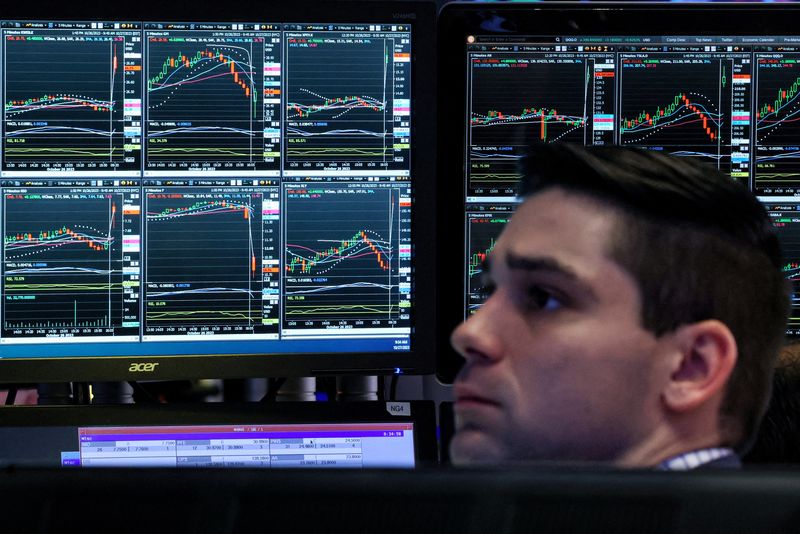Analysis-Global small-cap stocks lure bargain hunters after sluggish 2023
2023.12.07 01:26

© Reuters. FILE PHOTO: A trader works on the floor at the New York Stock Exchange (NYSE) in New York City, U.S., October 27, 2023. REUTERS/Brendan McDermid
By Samuel Indyk and Lewis Krauskopf
LONDON/NEW YORK (Reuters) – Shares of smaller companies that have lagged for most of 2023 are drawing investors on both sides of the Atlantic, as they weigh the benefits from an expected fall in interest rates next year against worries about a possible economic downturn.
In the U.S., the small-cap has jumped over 13% from its October lows, while the MSCI Europe Small and Mid Cap Index is up 12% since late last month.
The recent surge in small caps stands in contrast to much of the year. While the is up 19% year-to-date, the Russell 2000 has climbed just 5%. Europe’s small caps, meanwhile, have risen over 6% in 2023, versus a 12% increase in the broader MSCI Europe equity index.
That underperformance has helped make small caps look cheaper than their larger peers when compared to their historical valuations.
U.S. small caps are near their lowest-ever relative values to large caps, according to LSEG Datastream. The small-cap S&P 600 trades at 13.7 times forward earnings against its long-term average of 18 and well below the S&P 500’s current level of 19.
European small caps trade at a forward price-to-earnings ratio of 12.2, below the 15-year average of 15 and below the broader MSCI Europe’s current P/E of 12.3.
“We’re approaching 2-1/2 years of relative underperformance and if you look at the valuation multiples of small caps now, they’re very, very cheap,” said Rory Stokes, portfolio manager on the European equities team at Janus Henderson.
Those valuations have boosted the appeal of small caps in a multi-asset rally sparked by bets central banks globally will begin cutting rates in 2024 if inflation keeps falling. Recent data has shown U.S., European and British consumer prices cooling more than forecast.
Markets are pricing in over 125 basis points of rate cuts each by the Federal Reserve and European Central Bank next year following a hiking cycle that has lifted borrowing costs to their highest in decades, while benchmark government bond yields also have dropped.
That is good news for small caps, investors said.
Elevated borrowing costs can be more damaging to smaller companies, which tend to be more reliant on shorter-term debt that is now being financed at higher costs after years of rock-bottom interest rates.
The recent fall in Treasury yields “loosened the noose” around many small-cap companies, said Jack Ablin, chief investment officer at Cresset Capital.
U.S. small caps have outperformed large ones during periods of increasing growth and slowing inflation, with the Russell 2000 up an 25.2% on an annualized basis versus 17.3% for the S&P 500, a Morningstar Wealth analysis of data since the 1970s showed.
The firm is overweight small-caps in its U.S. equity fund, as cheap valuations give the stocks “some margin of safety,” said Marta Norton, Morningstar Wealth’s chief investment officer in the Americas. “That valuation opportunity has just expanded relative to large cap.”
Small-cap earnings also are expected to pick up. Russell 2000 companies’ earnings are forecast to increase about 30% next year after falling 11.5% in 2023, LSEG data showed.
“Small caps will snap back quickly and the recovery will be strongest in the early part,” said Amisha Chohan, head of small cap strategy at Quilter Cheviot. “It is important to have some exposure to this area of the market, especially given where valuations sit.”
Recent small-cap stock winners include wireless audio company Sonos (NASDAQ:), which has jumped over 40% in the past month, while Victoria’s Secret & Co has gained 33% during that period, and Britain’s Hotel Chocolat soared after the company agreed earlier this month to a takeover offer from confectionary giant Mars Inc.
Reasons for caution remain. While hopes of a so-called economic soft landing have supported stocks, some investors worry the rate hikes will bring a recession in 2024.
That would likely hurt small caps, which tend to suffer disproportionately in downturns. Since 1980, the Russell 2000 has lagged the S&P 500 by an average of about four percentage points in the six months after the economic cycle has peaked, ahead of a recession, data from Strategas showed.
“There is a legitimate case to be made that the economy could struggle sometime in the next 12 to 18 months,” said Bryant VanCronkhite, senior portfolio manager at Allspring Global Investments. “If that’s the case, the valuations we see today are probably not going to support small caps.”
Mabrouk Chetouane, Natixis IM’s head of global market strategy, believes that thinning year-end trading, recession worries and central banks’ insistence that it is too early to consider cutting rates argue for avoiding small caps.
“If we have a negative shock, then volatility will be more elevated in segments of the market where liquidity is weak,” Chetouane said. “From a tactical point of view, it’s not the time to buy or add small caps.”








